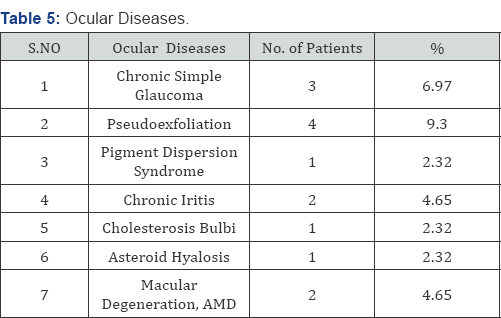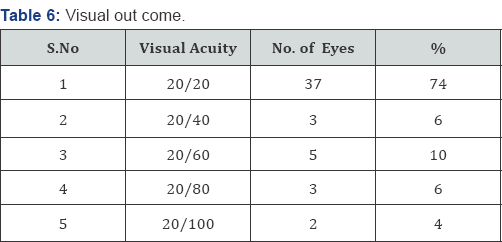Juniper
Publishers- JOJ Ophthalmology
Abstract
Purpose: To evaluate the results of
phacoemulsification surgeries at department of ophthalmology at Indus
Medical College Hospital Tando Mohammad Khan.
Material and Methods: This study in which only
50 eyes of 43 patients were included to treat by phaco emulsification
was conducted from 1st January to 30th June 2016. 31 patients were male
whereas 12 were female. 20 were right eyes, 16 were left while 7
patients were undergone bilateral phaco surgeries within 7 to 16 days.1
patient was in age group C, another 1 was in group D, 8 were in group E,
12 were in group F and remaining 21 were in group G. 21 were suffering
from diabetes, 12 were hypertensive, 2 were with cardiac problems using
pace maker and 2 was involved with HCV infection. Patients suffering
from ocular diseases: open angle glaucoma 3, pseudoexfoliation 4,
pigment dispersion syndrome 1, chroniciritis 2, cholestrosisbulbi 1,
asteroid hyalosis 1, age related macular degeneration 2 Eyes were
dilated with mydriacil/phenylephrine eye drops, local anesthesia as
retrobulbar as well as facial block (von lint technique) were given
using 2% xylocaine inj without adrenaline. 2.8mm incision,
capsulorexhsis with bent 27 gauge needle, followed by hydrodissection
and in some hydrodelienation with small caliber irrigation cannula,
copious 2% methylcellulose used to save endothelial cells as well as to
maintain anterior chamber, all 4 steps of phaco followed with divide and
conquer method and finally injectable intraocular lens implanted. Every
operation ended with subconjunctival injection of dexamethasone 2mg
plus gentamicin 20mg.
Results: 37 eyes gained 20/20 visual acquity
on first post-operative day, 3 eyes gained 20/40, 5 gained 20/60 which
over a period of five days improved to 20/20 after using topical
prednisolone 1mg along with moxifloxacin eye drops, 3 gained 20/80
corrected with glasses, 2 were having 20/100 because of macular
diseases.
Conclusion: In our experience
phacoemulsification is an excellent technique which saves time, gives
early rehabilitation depending upon the patience, experience and skill
of surgeons.
Keywords: Cataract; Phacoemulsification resultsIntroduction
The term cataract is defined as an opacification of
crystalline lens, having different morphological types; subcapsular;
anterior and posterioir, cortical, nuclear opacification [1]. Cataract further divided according to density: grade 1 to grade 4. Cataract leads to decreased or blurring of vision.
Mostly senile [2]
with other important causes like trauma, dibetes, myotonic dystrophy,
atopic dermatitis, neurofibromatosis type 2, steroid induced, chronic
iritis, high myopia, retinitis pigmentosa, gyrate atrophy, Stickler
syndrome etc. [3].
With the passage of time lens increases in weight and
thickness as new layers of cortical fibers are formed concentrically,
the lens nucleus undergoes compression and hardening (nuclear
sclerosis). Crystalline (lense proteins) are changed by chemical
modifications and aggregation into high- molecular-weight proteins [4].
The only treatment for cataract is surgery either
large incision ECCE or phacoemulsification, small incision early
rehabilitation and with good visual outcome. The technique and results
of cataract surgery have changed dramatically during the past three
decades. In all over the world we have moved from intracapsular cataract
extraction as the preferred technique to almost exclusively
extracapsular techniques. Smaller incisions have become thestandard,
with phacoemulsification now being the method of choice for most of
surgeons [5].
Material and Methods
This study in which only 50 eyes of 43 patients were
included to treat by phaco emulsification with injectable intraocular
lens implantations at Indus Medical College Hospital Tando Mohammad Khan
from 1st January to 30th June, 2016. All eyes
were dilated prior surgery with mydriacil, phenylephrine eye drops,
local anesthesia given using retrobalbur and facial (von lint) with 2%
lidocaine (xylocain injections). Phaco done with infinity (Alcon)
machine under Taggaki microscope.

Out of 43 patients 12 were females, 31 were males (Table 1),
patients were divided into different age groups as: there was no
patients in group A and B, group C and D have only one patient
respectively, group E includes 8, group F includes 12 and group G
includes 21 (Table 2).



Out of 50 eyes 20 were right, 16 left and 7 were both
eyes (Table 3). 37 (86.04%) Patients Were suffering with systemic
diseases like diabetes (48.83%), hypertention (27.90%), cardiac problem,
using pacemaker (4.65%), HCV (4.65 %) underwent surgery after having
fitness from their physicians (Table 4) 14 (32.55%). Patients were
suffering from ocular diseases like Glaucoma (6.97%), pseudoexfoliation
(9.30 %), Pigment dispersion syndrome (2.32%), old healed iritis with
peripheral ant Synaechae (4.65%), Cholesterosisbulbi (2.32%), asteroid
hylosis (2.32%), Age related macular degeneration (4.65%) (Table 5).

After asceptic techniques, drapping and using 2 drops
of 10% povidine solution instilled into eye, after 1 minute copious
irrigation done, incision started with 2.8mm phaco knife, capsulorexhsis
done with 27 gauge bent needle, hydrodissection and in some hydrd ilea
nation using small caliber irrigation cannula, copious use of 2%
methylcellulose to save endothelium as well as to maintain anterior
chamber. All 4 steps of phaco followed and finally injectable
intraocular lens implanted. Wound closed with stromal hydration. Every
operation finished with sub conjunctival injection of Dexamethasone 2mg
plus gentamicin 20mg, and eye kept pached for 24 hours.
Results
50 eyes of 43 patients were undergone surgery by
phacoemulsification with injectable intraocular lens implantation, 37
eyes (74%) improved visual acuity to 20/20 at first postoperative day, 3
eyes (6%) improved upto 20/40, 5 eyes (10%) upto 20/60, 3 eyes (6%)
upto 20/80, and 2 eyes (4%) improved upto 20/100 (Table 6). Figure 1 a, b, c shows injectable lens implantation during one of our surgery.


Discussion
Phacoemulsification is a very safe and less time
taking technique depending upon good dilation of pupil pre- operative
and during surgery as well as the patience, experience and skill of
surgeons. It is established that the smaller phacoemulsification wound
gives less induced astigmatism, faster visual rehabilitation and
improved wound security than ECCE [6-11]. Smaller wound heals more rapidly with less risk of leakage, viscoelastic do not leave the eye through small incision [12].
37 (74 %) of my patient improved visual acuity upto 20/20 on first and
secondday, 3 (6%) developed striate keratitis and treated with topical
steroid and regained 20/20 on 5th post operative day. In 5 (10%) visual
acuity corrected.
With glasses with in -1.50 D sphere and 0.75 cylinder
at 90degrees, 2 (4%) who were suffering with age related macular
degeneration remained after BCVA at 20/100. In our study not a single
case suffered with post operative endophthalmitis same as in a study
done by Cooper et al. [13].
Out of these 50 eyes only 3 developed striate
keratitis, reason was hard nucleus more than grade 3 density needed high
phaco power and time by the technique divide and conquer same as
described by Gimbel [14].
Topical steroids were being prescribed and on 5th postop day vision
become 20/20. Though it was fairly high 20% in one study by Popiela G et
al. [15]
but in our experience it was only 6 %, a grade 3 nucleus (severely
dense) and long absolute phaco time as independent predictors for
endothelial cell loss [16].
Phacoemulsification in the capsular bag by directing probe away from
the corneal endothelium and keeping the lens fragments at deeper plane
are the measures which would be helpful in minimizing the chances of
corneal edema and striate after phacoemulsification same as suggested by
Zetterstrin C [17] and Pirazzoli G et al. [18].
Conclusion
Small incision surgery such as phacoemulsification
with injectable intraocular lens implantation is a very safe and less
time taking technique which depends upon the experience and skill of
surgeon who strictly follows selection and exclusion criteria and with a
good knowledge when to abandon or convert the technique and always
keeps the lens fragments in the capsular bag with the phaco tip directed
away from endothelium, do not follow the lens fragments near the
posterior capsule, allow fragments' to follow the tip.
Acknowle dgement
I am thankful to Aftab Ahmed Khan assistant professor
for his assistance, Aisha Khan (4th year MBBS) and Atiqa Khan (final
year BDS) students for their help in compiling data. Special thanks to
my assistant Moin Shaikh who assisted all cases. Jawaid Iqbal assistant
professor who is always helpful.
For more articles in JOJ Ophthalmology (JOJO) please click on: https://juniperpublishers.com/jojo/index.php
No comments:
Post a Comment